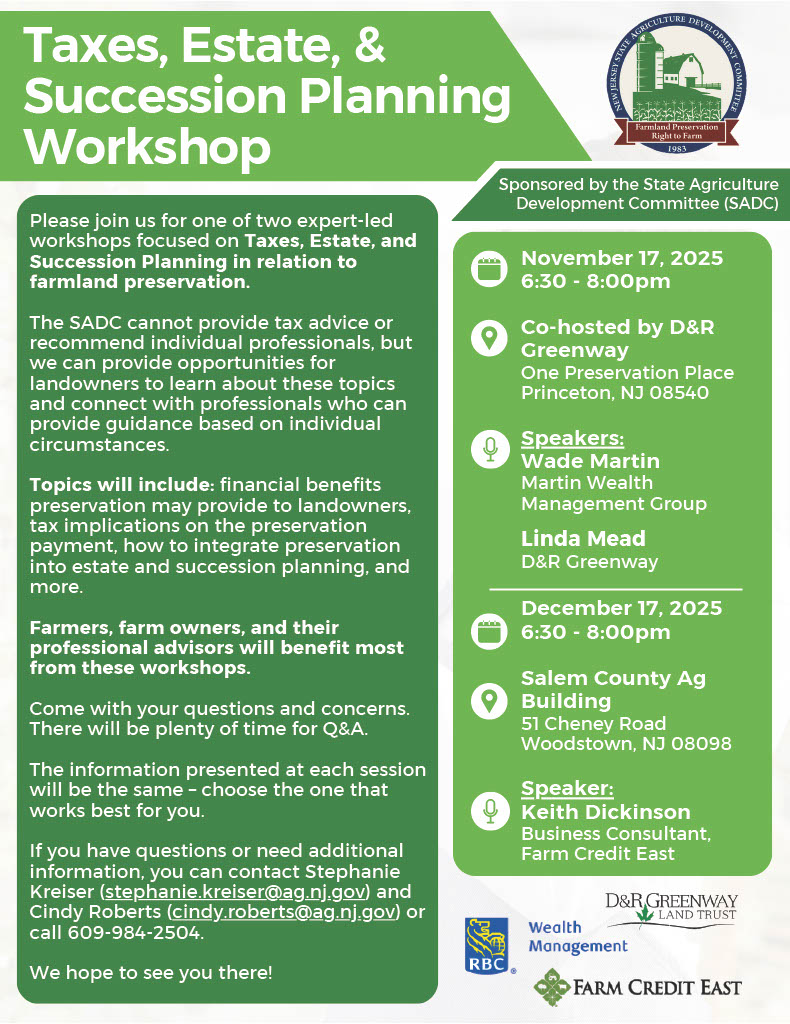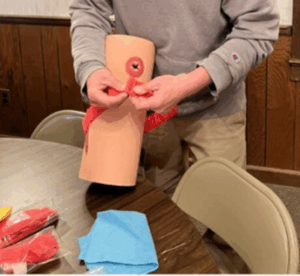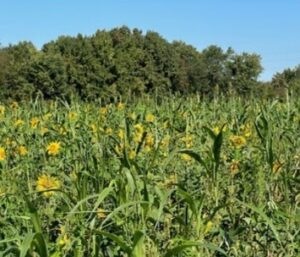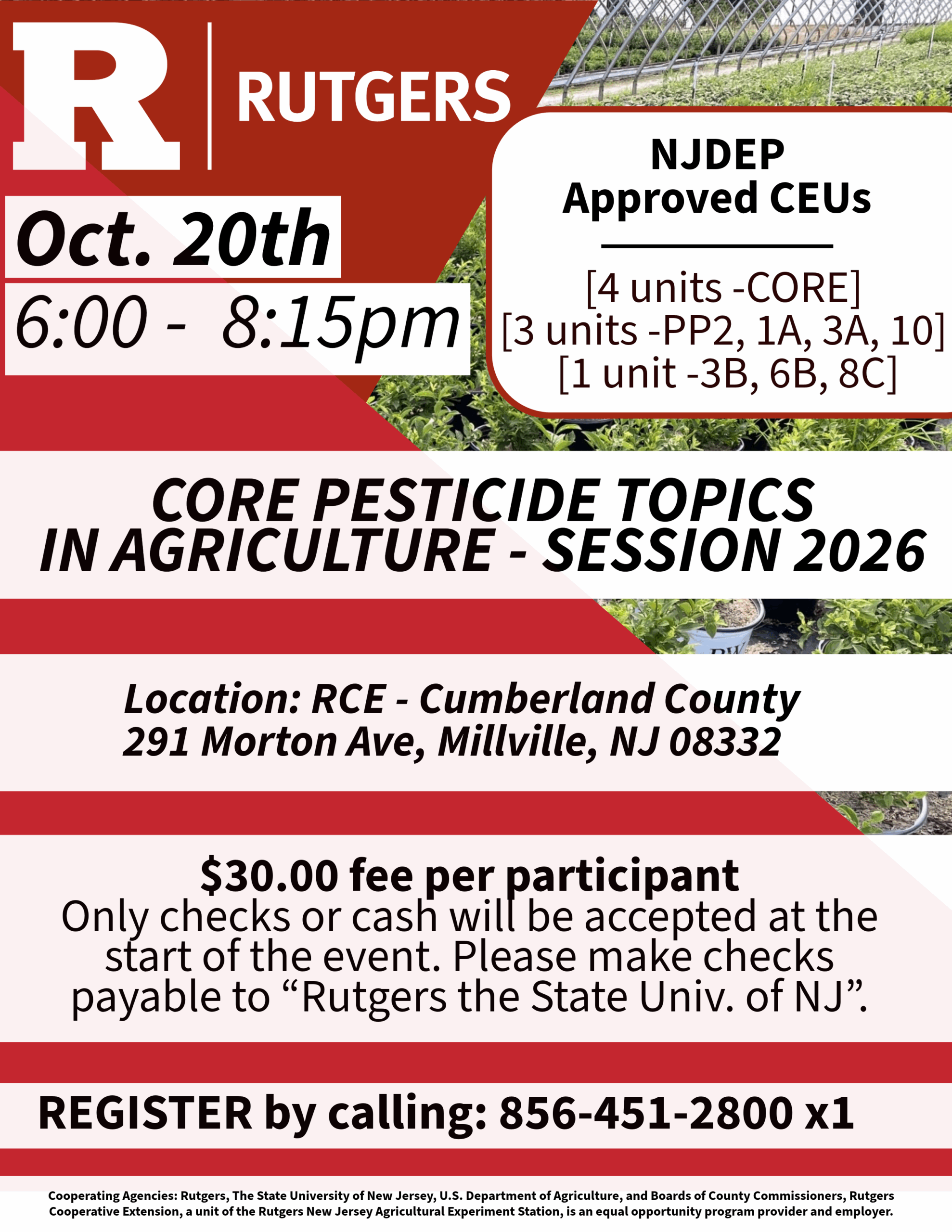 The NJ Department of Agriculture, State Agriculture Development Committee (SADC) has two upcoming workshops on ‘Taxes, Estate, and Succession Planning’ as they relate to farmland preservation. These in-person workshops are best suited for farmers, farm owners, and their professional advisors. This is not a series – select the workshop location closest to you. [Read more…]
The NJ Department of Agriculture, State Agriculture Development Committee (SADC) has two upcoming workshops on ‘Taxes, Estate, and Succession Planning’ as they relate to farmland preservation. These in-person workshops are best suited for farmers, farm owners, and their professional advisors. This is not a series – select the workshop location closest to you. [Read more…]
Christmas Trees Edition
EMAIL | RSS
Seasonal pest alerts and news about insects, diseases, and weeds impacting Christmas Tree production including Commercial Ag Updates (meetings and marketing); and Pesticide Program updates from the Rutgers Pest Management Office News Blog.
Companion Website Links:
 Rutgers Weather Forecasting - Meteorological Information important to commercial agriculture.
Rutgers Weather Forecasting - Meteorological Information important to commercial agriculture.
Workshops on Taxes, Estate, and Succession Planning
South Jersey Farmers – Stop the Bleed Training – February 2, 2026
STOP THE BLEED TRAINING
FOR FARMERS AND THE AGRICULTURAL COMMUNITY
REGISTRATION REQUIRED – NO COST
REGISTER USING THIS LINK OR QR CODE:
https://go.rutgers.edu/stopthebleed
DATE: MONDAY, FEBRUARY 2, 2026 TIME: 9:00AM
LOCATION: GLOUCESTER COUNTY OFFICE OF GOVERNMENT SERVICES
1200 N. DELSEA DR., CLAYTON, NJ
Rutgers Cooperative Extension’ Farm Health and Safety Team has partnered with the Gloucester County Emergency Services to provide “Stop the Bleed” training for the farming community.
Don’t miss this opportunity to learn the life-saving skills of pressure application, wound packing, and use of tourniquets. The first 25 registrants will also receive a complementary bleeding control kit.
Space is limited, register today.
If you have questions contact Rutgers Cooperative Extension of Gloucester County 856-224-8040 ext. 1 or email minfante@njaes.rutgers.edu
Rutgers Farm Health and Safety Team:
Agricultural Agents: Kate Brown, Michelle Infante-Casella, William Bamka, and Stephen Komar
Northeast Sustainable Agriculture Research and Education – Farmer Grant Applications Available – Due December 9, 2025

The Call for 2026 Northeast SARE Farmer Grant applications is now available. Awards of up to $30,000 are available, depending on the complexity of a project. Proposals are due no later than 5:00 p.m. EST on December 9, 2025. The NJ SARE Coordinator is Stephen Komar, Agricultural Agent in Sussex County and Michelle Infante-Casella is the Assistant Coordinator for SARE in NJ. If you have questions you can send an email to Steve or Michelle, or contact your local county Rutgers Cooperative Extension Agricultural Agents who can assist and also provide technical assistance.
Northeast SARE Farmer Grants provide the resources farmers need to explore new concepts agriculture conducted through experiments, surveys, prototypes, on-farm demonstrations or other research and education techniques. Projects address issues that affect farming with long-term practical impacts in mind.
Farmer Grants are designed to be a strong starting point for farmers interested in pursuing grant funding of projects. Before starting their proposals, potential candidates identify a Technical Advisor who can provide non-farming expertise in areas such as research design, troubleshooting, and promotion. The Technical Advisor acts as a go-to support person throughout the grant project, making it easier on first time grantees and forging new relationships in agricultural communities across the Northeast.
Northeast SARE funds projects in a wide variety of topics, including marketing and business, crop production, raising livestock, aquaculture, hydroponics, silvopasture, and more.
Northeast SARE covers the Northeast and Mid-Atlantic states of Connecticut, Delaware, Maine, Massachusetts, Maryland, New Hampshire, New Jersey, New York, Pennsylvania, Rhode Island, West Virginia, Vermont, and Washington, D.C.
The Farmer Grant program is specifically for farmers. Northeast SARE will be releasing calls for proposals for other grant programs in the coming months.
For applications, tutorials on farmer grants, and other important information about this grant program see the NESARE Farmer Grants Webpage.
In-person CEU session – 10/20/25 – Cumberland Co. RCE
Register by calling (only): 856-451-2800 ext. 1

Note: October 7th – Ornamental Twilight meeting has been postponed until Spring 2026

